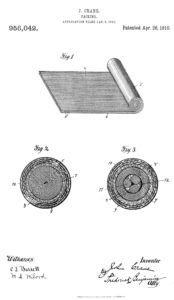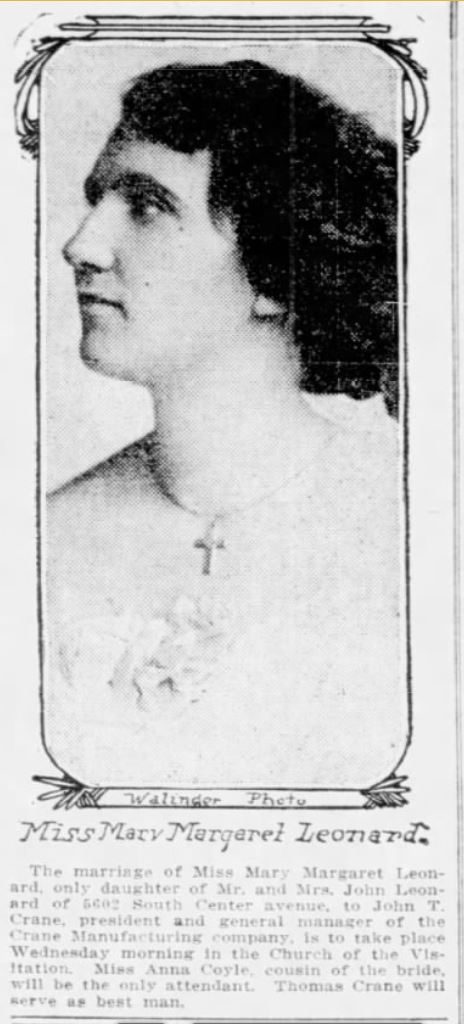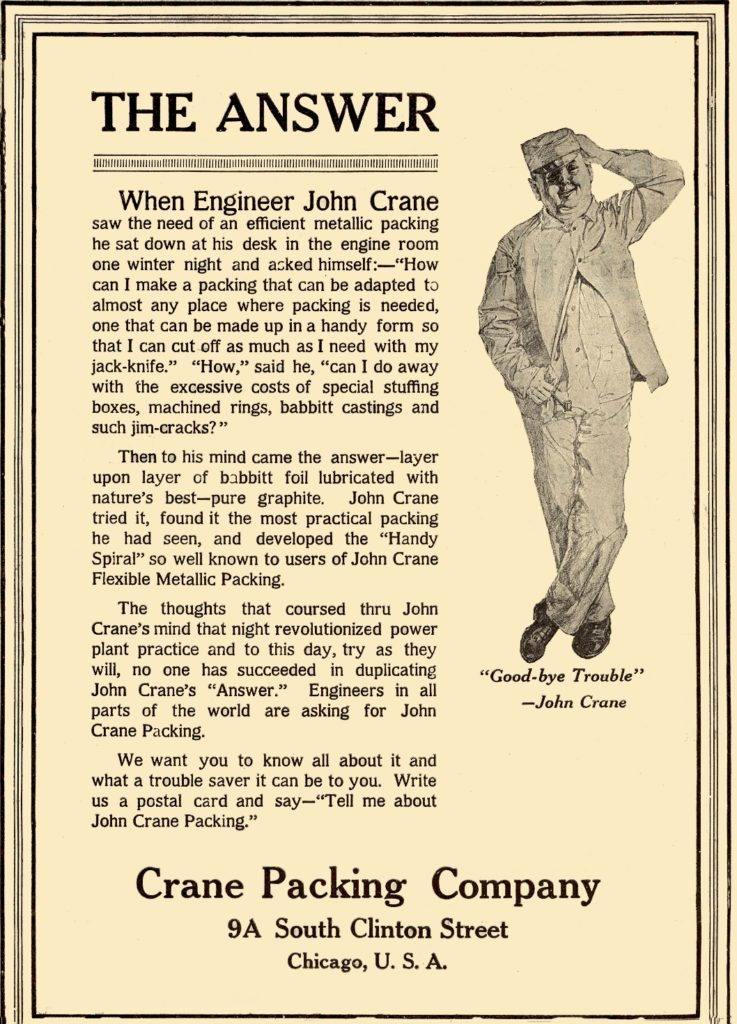John Crane Group, part of the Smiths Group of the United Kingdom, is headquartered in Chicago, Illinois. John Crane is the largest and one of the oldest mechanical seal companies; it was incorporated as Crane Packing Company on March 9, 1917 in Chicago, Illinois. This is the story of John Crane — the person.
John Crane
John Crane – the person – was a Stationary Fireman in a power plant in Chicago when he conceived the idea of using alternating layers of lead and graphite to make packing. For his idea, John Crane was awarded U.S. patent 956042 on April 26, 1910 when he was 29 years old. In his patent, he describes the manufacture of his packing. Thin lead sheets were coated with graphite paint,

placed in layers and rolled into a cylinder. This rolled cylinder was first covered with a fine cotton wicking and then wrapped with flax or hemp twine. The final manufacturing steps were to apply graphite paint to the outer layer and roll the cylinder in powered graphite before the paint dried. John Crane’s packing was said to be “elastic and at the same time of a plastic character, so that it will yield readily to pressure and may be easily molded to conform to the irregularities of the surfaces with which it is in contact”.
There is no biography of John Crane and, in fact, very little information about him. However, from his patents, a few newspaper notices, the federal census and with cooperation from some of his descendants, a short sketch of his life is presented herein.
John Crane was born November 13, 1881 in Illinois, probably in Chicago. His father (name unknown) and mother, Mary, were both born in Ireland. His mother came to America in 1870. His full name was John Thomas Crane; strangely, he had a younger brother also named Thomas. Both John and Thomas were born in Illinois.
In 1900, the 19 year old John Crane was living in a rented house on South May Street in Chicago with his mother, Mary, and his brother, Thomas. His mother was not employed; she could not read or write but did speak English. Thomas Crane was employed as an office boy. John Crane was employed as a Stationary Fireman – meaning that he operated and maintained stationary steam engines and associated equipment. In a later census, John Crane indicated that he had a fifth grade education.
By 1910, John and Thomas Crane lived with their mother in a house that she owned on Grenshaw Street in Chicago. Thomas was employed as a clerk in a steel company. John was an engineer for a bakery. These may have been the same positions and companies as in 1900.
The anecdotal background to John Crane’s invention is that, an avid cigar smoker, he first used lead foil cigar wrappers to make his packing. But a 1918 issue of “Fire and Water Engineering” noted that in 1912, John Crane had charge of a large power plant and was directly responsible for maintenance and repair costs. From his experience, he knew that soft packings lasted only about four or five months in the plunger feed pumps. He found that where metal and fabric were combined, the life of such packing was increased and that the metal was less damaged. This led him to the idea of an all metal packing. After some experimentation, he developed packing that used long, thin, continuous strips of soft metal foil (babbitt) wrapped spirally and impregnated with a layer of graphite.
A 1919 advertisement in Power Magazine presents a more analytical development. According to that advertisement, John Crane “sat down at his desk in the engine room one winter night and asked himself: ‘How can I make a packing that can be adapted to almost any place where packing is needed, one that can be made up in a handy form so that I can cut off as much as I need with my jack-knife.’”
John Crane Advertisement 1919On June 25, 1913, John Crane married Mary Margaret Leonard, the only daughter of John Leonard and Bridget Gallagher. Both John Leonard and Bridget Gallagher were born in Ireland. Mary was born about 1891 in Pennsylvania. John Leonard was a laborer in an iron foundry. In the newspaper announcement, John Crane’s name was given as “John T. Crane” and his occupation as President and General Manager of the Crane Manufacturing Company. John’s brother, Thomas, was Best Man at the wedding. By 1919, John Crane and Mary Leonard Crane had three children: Margaret, John Thomas (Jr.) and Mary Lorraine.

At the time of his wedding, John Crane had his patent but Crane Packing Company had not been formed. It seems likely that John Crane was making his special packing himself or perhaps with the help of a few employees as Crane Manufacturing Company.
In 1915, John Crane received his second patent, U. S. Patent 1151344, for improvements to his first patent. In the improved version of his packing, the outer, fibrous, painted layer was not used; however, the improved packing also differed from the original in other ways. The improved packing was made by wrapping thin metal foil around a fiber or wire core and molded into a square or rectangular cross section. John Crane’s improved packing could be manufactured more efficiently than his original packing. Like his first patent, the second patent was not assigned to any person or company.
In 1916, John Crane received his third patent, U. S. Patent 1206306, for further improvements to his two earlier patents. The third patent describes how the thin soft metallic layers are wrapped around a soft core in a helical pattern. This patent was assigned to Crane Packing Company, a partnership – not yet a corporation — consisting of Frank E. Payne and John Crane.
Frank Payne
Frank Payne was a salesman for Warren Steam Pump Company when he met John Crane. He was soon selling Crane’s packing, perhaps made by “Crane Manufacturing Company” on commission. Frank Payne left Warren Pump and joined John Crane at Crane Packing Company in 1916; however, Crane Packing Company was not incorporated at this time. John Crane and Frank Payne set up shop in the second floor of 31 South Clinton Street in Chicago.
In a 1916 advertisement in Power Magazine, “John Crane Flexible Metallic Packing” was offered on approval by Crane Packing Company. This packing was offered for use in vapor or liquid services ranging from static gaskets to reciprocating rods, valves and centrifugal pumps. Maximum pressure was said to be 5000 psig and maximum temperature was 600 F.
On March 9, 1917, Frank Payne incorporated Crane Packing Company. The value of the corporation was placed at $50,000. Frank’s brother, Arthur, was placed in charge of sales.
Ten days after the incorporation of Crane Packing Company, John Crane and Frank Payne filed jointly for another patent on March 19, 1917 and they were granted U. S. Patent 1271526 on July 2, 1918. This packing included a laminated layer, or backing strip, on the non-wearing side of the packing. This backing strip, made of soft flexible material, such as canvas or rubber, was intended to improve sealing against damaged surfaces.
Within a year after its incorporation, John Crane was no longer a part of Crane Packing Company Inc. It should be noted that members of the John Crane extended family believe that John Crane hired Frank Payne and then was, somehow, taken advantage of by him. No doubt their version of the story was handed down by relatives who were more directly involved and affected. However, legend has it that terms of the breakup included a transfer of Payne’s grand piano to Crane because Crane’s daughter, Margaret, needed it for music lessons. This legend is true and John Crane’s grandson fondly recalls his Aunt Margaret playing that grand piano extremely well. Otherwise, documentation of the reasons and financial settlements for John Crane leaving Crane Packing Company are not available.
In 1919, Crane Packing moved from the original location, 31 South Clinton Street, to 1800 Cuyler where it remained until 1956. The current location, 6400 West Oakton, in Morton Grove, was acquired in 1950 and by 1956 all Crane Packing operations had been moved to Morton Grove.
Life After Crane Packing Company
The late teens and early twenties of the twentieth century must have been stressful and tumultuous years for John Thomas Crane. He had progressed from being a “fireman” to having a patent and being president of his own company. He had been granted additional patents and became part of a corporation that was named after him. He was married with three children. He then sold his shares in Crane Packing Company Inc. and left that company – apparently never to associate with it again.
All U.S. citizens were required to register for the draft during World War I. When John Thomas Crane registered on September 12, 1918, he gave his occupation as Secretary Treasurer of Goodsell Packing Company of Chicago. Therefore, he had left Crane Packing Company Inc. by that time. At the time of his registration, John T. Crane was living at 314 North 1st Ave in Maywood, Cook County, Illinois with his wife and family. In his registration, he was described as medium height and stout with brown eyes and black hair. He was 36 years old with no physical disqualifications for military service. Interestingly, his brother-in-law, John Gallagher Leonard, registered for the draft on the same day. John Gallagher Leonard’s address was 318 North 1st Ave so he lived near to John T. Crane and his own sister, Mary. John Gallagher Leonard gave his occupation as Factory Superintendent at Crane Packing Company! Apparently, John T. Crane had obtained a job at Crane Packing Company for his brother-in-law before becoming disassociated with the company himself.
Goodsell Packing was a packing company located in Maywood, Illinois where John T. Crane lived. Goodsell was a packing manufacturer founded by Byron Woodward Goodsell in 1886. Goodsell offered several different types of packing, including flexible metallic packing. Apparently, shortly after his disassociation with Crane Packing Company Inc., John T. Crane went to work for Goodsell Packing and remained there for several years.
In 1919, John T. Crane applied for another patent, but this one was for a line shaft bearing. He was granted Patent 1345534 in 1920.
Although he was an employee of Goodsell Packing, in the 1920 census, John T. Crane described his occupation as a machinist in the manufacturing industry and noted that this was his “own account”; in other words, his own business.
In 1920, John T. Crane again applied for a patent for packing. This patent, 1466641, was granted in 1923 and assigned to Chicago Metallic Packing Company.
In the early 1920s, John T. Crane lived at 87 Huron Street in Maywood. In 1922 and into 1923, he advertised this house as being for sale and asked prospective buyers to contact him at Goodsell Packing Company. The house was described as being a ten room stucco house with sun and sleeping porches, two toilets and bath, a shower in the basement, a garage and a beautiful location adjoining a forest preserve and the Des Plaines River. This house was built in 1919, perhaps specifically for John T. Crane or soon purchased by him. It remained in the extended John T. Crane family for many years. Perhaps it was sold to his brother-in-law, Tim Leonard, in the mid-1920s. In the 1930s, 87 Huron Street was owned by John T. Crane’s daughter, Mary Lorraine Crane, and her husband Martin Wilson.
In 1925, John T. Crane applied for a patent on brakes and was granted Patent 1637894 on August 2, 1927. His idea was to use a metallic friction element. In this patent, John T. Crane appears to be using his experience with laminated metallic packing to make a brake lining.
Interestingly, at the time he was granted the brake patent, John T. Crane was living in Los Angeles, California. Apparently, after selling 87 Huron, John T. Crane moved to California. That trip must have been quite an adventure in those days and in later years John T. Crane would describe it and fording streams along the way to his grandson. According to his grandson, John T. Crane and his wife Mary actually lived on Roxbury Avenue in Beverly Hills. During this time, especially in 1927, John T. Crane’s daughter, Margaret, is mentioned in various California newspapers for her role as a pianist. Her nephew, John T. Crane’s grandson, recalls that Margaret was quite an accomplished pianist and he heard her playing the grand piano (the one given by Frank Payne) many times.
By the 1930s, John T. Crane had returned to Illinois where he was granted three patents relating to packing and gaskets; all were assigned Felt Products Manufacturing Company.
In the 1940 census, John T. Crane described his occupation as “Inventor” in the electrical appliance industry. However, in the draft registration for World War II, he gave his employer as Stanley’s Restaurant in Chicago.
John T. Crane’s grandson vividly recalls John Crane Sr. still inventing in the 1950s while living with his son John Crane Jr. in Maywood. At one time, John Crane Sr. was working on a brake shield using paper, graphite and iron filings. He went to the Crane Packing Company plant in Morton Grove for help but was thrown out. Imagine! Although normally a cheerful man, this hurt his feelings. Apparently, no patent was granted for this brake shield.
John Thomas Crane died May 28, 1962 in Maywood, Illinois. His obituary does not mention packing, Crane Packing Company or any of his inventions.
Patents Granted to John Thomas Crane
There are several packing related patents issued to a John Crane (the person) including some in the 1930s. The strange thing is that patents issued before 1920 are in the name of “John Crane” but afterward issued to a “John T. Crane”. These are the same person. Perhaps contractually “John Crane” (the person) could not use the short form of his name? Or perhaps John T. Crane wished to emphasize that he was a person and not a corporation?
Historically, the reason given for using the “John Crane” product name and “Crane Packing Company” as the manufacturer has been the local fame of John Crane the person but there may have been other reasons as well.
About the same time as John Crane was living in the Chicago area, Richard Teller Crane was building his manufacturing businesses, including Crane Valve Company. John Thomas Crane does not appear to be part of the Richard Teller Crane family or businesses. On the other hand, by creating Crane Packing Company and using the “John Crane” trademark for its products, perhaps Frank Payne was more interested in taking advantage of the (Richard Teller) Crane name than the local fame of John Crane (the person)?
John T. Crane had established Crane Manufacturing Company by 1913 and was already selling “John Crane” packing when Crane Packing Company was incorporated. The simple explanation for keeping the “John Crane” product name as well as slightly renaming Crane Manufacturing Company is probably that the company name and products were already becoming well established.
As summarized below, John Crane was granted ten patents. It appears that his patents brought everlasting fame to his name but probably not fortunes to John Crane – the Person.
His grandson noted that when asked about his lost company, he said “When I made an item I would let the person use it for three months or so and if it still worked, they could pay me then. Well, we had a good run.” He was a cheerful person and was never vindictive.
John Thomas Crane was an inventor – not a businessman.


